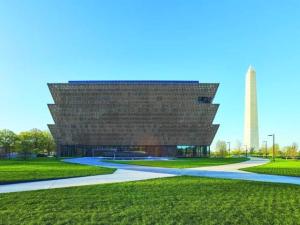By Micha Green,
AFRO D.C. and Digital Editor,
mgreen@afro.com
When the Smithsonian National Museum of African American History and Culture (NMAAHC) opened its doors it had been a long time coming to celebrate a monumental moment for Black people and American history. The first Smithsonian institution dedicated, solely, to Black history and culture, NMAAHC is the largest museum of African-American collections in the world. Further, its state-of-the-art and eye-catching exterior build is the first museum on the National Mall designed to sustainability standards, thus serving as the Smithsonian’s “Green Flag.” However, the building and museum itself are not NMAAHC’s only “firsts.” The museum’s collections are filled with extraordinary and everyday “firsts and fews” that show the true strength and resilience of Black people and culture; and the efforts surrounding NMAAHC, show the collective power of African Americans working together historically and presently for an even stronger future.
In an exclusive with the AFRO, NMAAHC’s first Director of Advancement, Adrienne Brooks, shared the joy she’s had working with the museum and all its monumental firsts, programming, achievements, supportive members and guests and collections.
“It’s a day I will never forget: Sept. 24, 2016, because by then I had been working with the Museum for almost 10 years. So, this was the day we were working for, waiting for, this moment where we opened to the public. So I can’t begin to tell you the excitement that was building around it and how wonderful it really felt that so many people wanted to be part of this opening,” Brooks said when talking about the NMAAHC’s historic opening.
“We knew our people were really waiting for this day, so we did a strong outreach and people were just excited. We filled the Mall, and outside the museum, there was a sea of people and it was such an exciting moment. We went from the dignitaries, from the Barack Obamas of course, to the members of Congress, etc., to our regular everyday members, who have been so important to this Museum and making it happen. So when you see that vast array of people engaged and excited, the buzz was in the air, of course President Obama, who was still in office then, was amazing, and he was with John Lewis, who was one of the original signers and one of the people who really made this possible by fighting for this Museum. He was there. And of course our Founding Director Lonnie Bunch. So we had a stellar group. From Stevie Wonder to Patti LaBelle we had wonderful singers and marching bands, and it was just a moment one will never forget. It was our moment, it was truly our moment and everybody in the crowd felt that.”
NMAAHC’s first director of advancement, who was charged with raising the hundreds of millions of funds for the museum’s opening, said that there was a wonderful group of people collaborating to find extraordinary support to establish the important location. Brooks said Black people showed up and showed out as supportive donors to bring NMAAHC from a great idea to a phenomenal Museum that catches people’s eyes from more than a half mile away of the crowded Washington, D.C. streets and National Mall.
“I have a whole team of people, wonderful fundraisers, some that specialize in corporate, some that specialize in individuals, some in membership, so we have a back office of a wonderful team in place that help make the funds happen and the fundraising happen. And so we always saw ourselves as part of the larger Museum’s story. I used to hear, ‘Oh, you know Black people don’t give. It’s going to be hard to raise money.’ All of those kinds of stereotypes that really aren’t true, and one of the things that I think that this Museum did, was to defy that stereotype. Absolutely, our campaign was driven by the generosity and support of Black people, others as well, I always want to acknowledge that this has been a campaign that really has hit a diverse audience, which has been extremely gratifying. But, Black and African-American people and people of African descent, have been critical, and I think that’s almost a first, as to how this community has stepped up to make this Museum happen because it’s a story that we want to have documented and shared for our future,” Brooks said passionately.

“One of the things I would often hear, when I would talk to potential donors, is, ‘I want my kids to understand or to know this story,’ or ‘My kids don’t know enough of this story.’ Parents in particular are always looking for a place where their children or their grandchildren can go to understand this story. And so that kind of energy and that kind of commitment for the future is also something that I feel is, not really a first for the African-American community, because in fairness, in very many ways we’ve done this kind of work within our communities smaller, but on a national scale, this has been particularly gratifying and very rewarding,” the NMAAHC director of advancement added.
Brooks said that one of her favorite parts about working at NMAAHC is the ability to always learn something new in her job and about Black history and culture. As the pandemic heightened the digital and virtual world, Brooks said she learned more about working virtually and is enjoying the Museum’s pivot in bringing exhibits to an online experience.
“The digital aspects we’re strongly into now, and we have a platform that is called the Searchable Museum, and it’s this virtual world where visitors can actually go in and pick up knowledge, see collections and get a deeper understanding of the stories that are in the Museum. So to me, I’m always learning and there are many first for many as I go through the Museum,” she said.
“I kind of fancied myself very knowledgeable in African-American history, but honestly I’m learning even today, every day. When I go in the museum, sometimes something will catch my eye, and I’m like, ‘I didn’t realize that was there and I’ll read the story.’ What the Museum brings out are the everyday stories of everyday courage, especially when you go back in history and time.
The everyday stories that are taking place throughout our various communities and our communities are different, but it’s those stories that I find , especially the stories of courage,” Brooks explained.
Brook said one particular aspect of the museum’s collection that particularly sparks her interest are the everyday people, living quotidian lifestyles of the day, who have been able to pass down extraordinary stories and memories.
“There’s an exhibit in the history gallery that shows, we call it a ‘tin wallet,’ but it’s basically this tin box. And this man used this tin box to carry his freedom papers, because, of course those of us who saw 12 Years A Slave know how if a person of color were caught in certain circumstances, he or she could be grabbed and sent back South because we were all considered slaves. And so Joseph Trammell had earned his freedom and his freedom papers, so he carried those with him every day, and it obviously meant a lot to him. But what is really amazing, is this was in the 1800s, that tin wallet was passed down generation, after generation, after generation,” Brooks explained.
“The family of Joseph Trammell brought it to the attention of the Museum and said ‘Finally! Here’s a home where we can share this story with everyone. And it’s those kinds of stories. Little stories, acts of courage, they are firsts for me as well. As well as some of the other brand names that we often hear about.”
While Trammell may have not been the first man with freedom papers, there are few family anecdotes and heirlooms such as his tin box carrying the lease to his liberated life as a Black man in the United States in the 1800s. Stories, exhibits and memorabilia such as Trammell’s is the exact reason why so many find the NMAAHC such a sacred place for Black Americans, many of whom have little knowledge of their African ethnic heritages.
NMAAHC is not just a first for Black people; it’s a roadmap to life, heritage, and culture and place to call home.
Help us Continue to tell OUR Story and join the AFRO family as a member – subscribers are now members! Join here!
The post NMAAHC first of its kind, making firsts, highlighting firsts, continuing legacy appeared first on AFRO American Newspapers .











